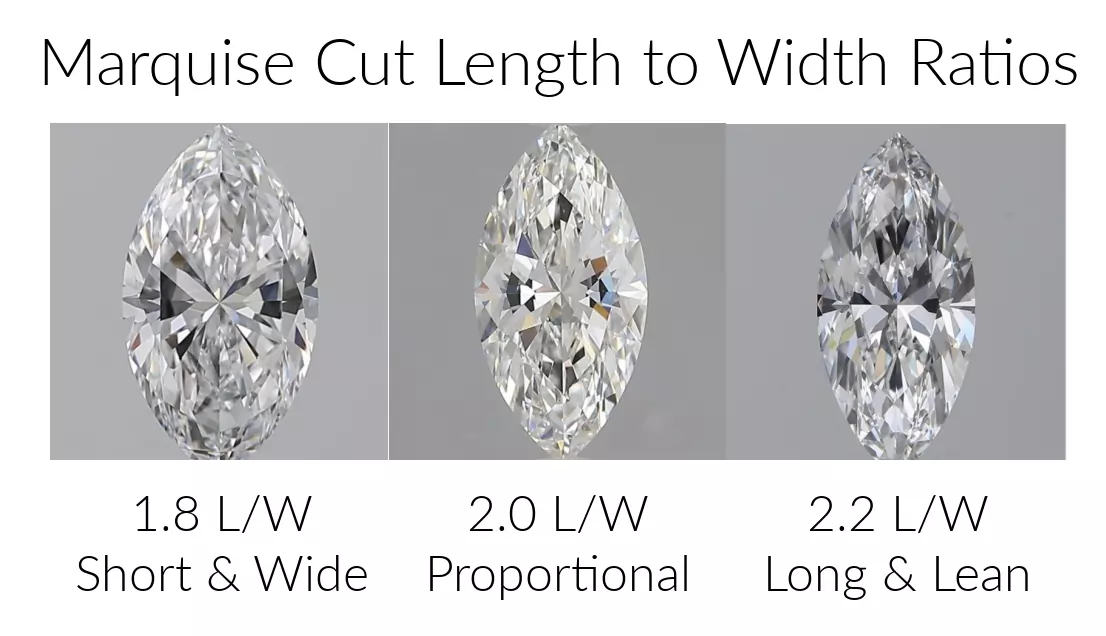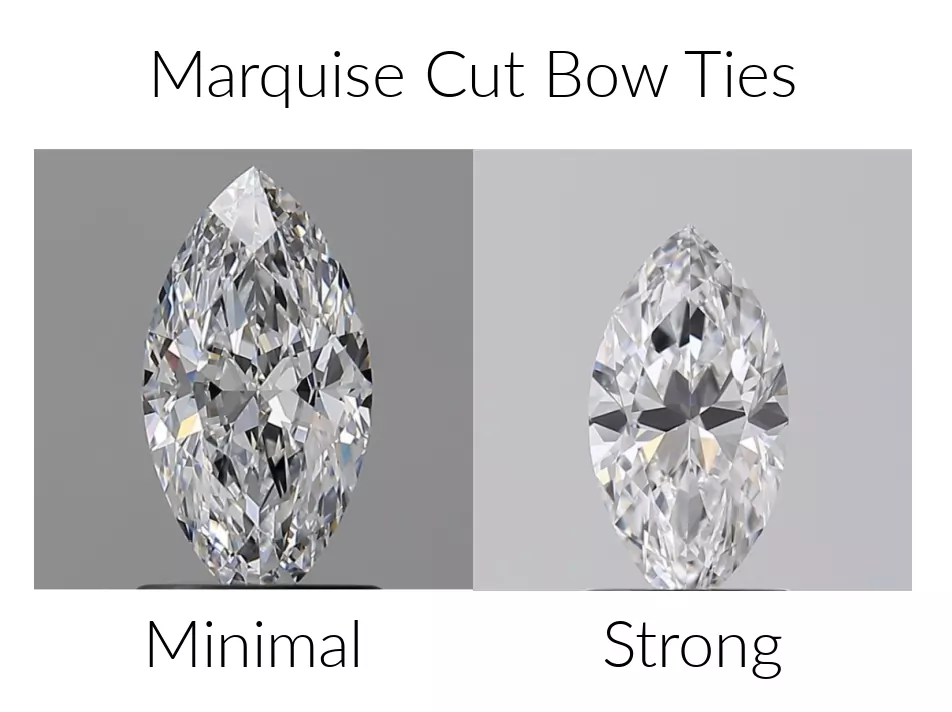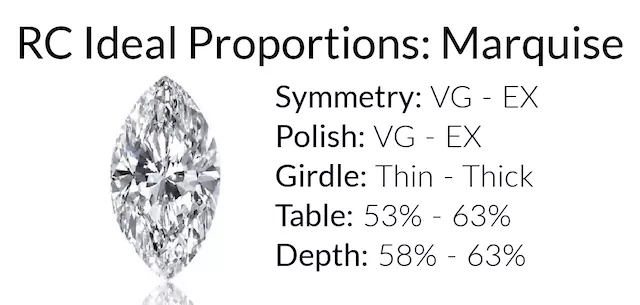What is the Marquise Diamond Cut looks like & Buying Guide?
What does a marquise diamond look like?
The Marquise diamond looks like a Boat, a Football, a Smile. All of these words have been used to describe the look & shape of a marquise diamond.
History of the Marquise Diamond Cut
Essentially an oval with pointed ends that has brilliant facets, the marquise first came about in the 18th century when French King Louis XV commission his court jewelers to fashion a diamond matching the smile of his main squeeze and mistress, Jean Antoinette Poisson aka the Marquise de Pompadour. Weird story, yes, but by giving the diamond the name marquise the King was showing the world that it's one aristocratic diamond shape. The term marquise (feminine form of marquess) referred to a hereditary rank midway between a duke and an earl. Pretty cool, huh?!
Just like any diamond shape, the marquise has come and gone out of style. It was all the rage back in the 80s...now, though, not so much. So if you're looking for a unique center stone shape, the marquise has got you covered!
Marquise Cut Upsides
Just like ovals, they are flattering to the finger (even the chunkiest of digits), as they elongate the fingers and make them look positively regal.
Next, they do tend to look slightly bigger than round stones of the same weight, so you can definitely get more bang for your buck with a marquise shape (they also tend to be cheaper!).
Finally, they are very unusual. If you are looking to break the mold a little with your choice of stone, the marquise is a good path to go down.
Downsides of the Marquise Cut
All of that being said though, there are three important things to note when buying a marquise, and they all involve Goldilocks. Yes, you read that correctly. The chick with the porridge. Intrigued? Read on.
Marquise Diamond Cut Length to Width Ratios
First, let’s discuss length-to-width ratios. As we have seen in other cuts so far in this series, a poor L/W ratio can mean the difference between a diamond that looks like it’s spent too long on a juice cleanse, and a diamond that’s been to an all you can eat buffet.
It is no different with a marquise – and in fact, I would argue that it’s even more important. I believe that sticking with a ratio of 2:1 is the Goldilocks state, in that it’s ‘just right’. Anything over 2.2:1 is going to look starved, anything below 1.8:1 is going to look chubby. Now, of course, if you like either of those looks you are welcome to go for them, I just think they are not as appealing to the eye;
Marquise Diamond Cut Bow Ties
Next, we must talk about bow ties. For those of you who have read my take on oval diamond cut buying guide, you will know that the dark specter of the bow tie is never too far away, ready to ruin our day. Bow ties are those dark shadows that fall across the face of the diamond if it has been cut too shallow.
To counteract this bow-tie, diamond cutters will attempt to cut the diamond a little deeper in the hope of diminishing the bow-tie effect as much as possible. The problem with this is, when a marquise diamond is cut too deep, you just end up getting a drab diamond.
Stick with the Ideal Proportions above to avoid a very pronounced bow tie. It should be noted again though, that in most cases the bow tie is merely diminished not eliminated completely. It’s the nature of the beast, unfortunately.
Marquise Diamond Girdles
Finally, on the Goldilocks front, I want to discuss girdles. Not the women’s boned undergarments that are designed to make you look fabulous while at the exact same time making you feel utterly miserable.
I’m talking about diamond girdles; the thin ‘belt’ that separates the crown (the top) from the pavilion (the underneath). We have a serious Goldilocks situation going on here with girdle thickness. A girdle that is too thick for example, will mean a lot of wasted space inside the stone (as well as a lackluster finish).
A girdle that is too thin on a marquise however, is even more dangerous. This is because the tips of the marquise diamond are extremely fragile (just like the princess diamond cut buying guide ), and with a weak girdle this can spell disaster for your precious stone, leaving it open to breaking and chipping. Your Goldilocks girdle thickness is as follows: you want a range of ‘thin’ to ‘thick’ only.
Marquise Color and Clarity
Next, let us touch on clarity and color. With clarity, feel free to pop down to the ‘VS2-SI1’ range, as marquise cuts (just like our ovals and cushions) are very good at hiding small imperfections. As usual though, you need to be careful about the positioning of these inclusions, as a dirty black mark sitting smack right in the center of your table could really burst your bubble.
Color is a little bit trickier, however. In general, we have learned that these modified brilliants (fancy cuts) tend to hold on to their color more than their round counterparts. This can be even more pronounced with the marquise cut, with the color looking even darker at those pointed tips. For this reason, I would suggest that you go for ‘G’ or above for a stone of about 1 carat, and even higher (‘D-F’) if going for a stone over 1.5 carats.
MARQUISE CUT DIAMONDS FAQ
Are marquise diamonds more expensive?
They also appear larger than other cuts because of the elongated shape as well as the overall depth being more shallow compared to most other shapes. So if you are looking for a large appearing stone for less money then marquise may be your shape!
What do I need to know about marquise diamonds?
Also, the two points on each end are very vulnerable to chipping and need to be properly covered with the setting. You will want to avoid any inclusions that are near these points as these can weaken the durability of the area. That's never good! You can do this by looking at the plot on your report and look for any red marks near the two points. Also you will want to make sure the prongs that are covering the tip is heavier or a V prong to protect it.
Lastly, there is something called a bow tie which can occur in a marquise diamond. This is a shadow that appears in the center of the stone. It can range from barely noticeable to extremely obvious. It's important to see an image of any marquise to ensure this does not occur in your diamond.
Are marquise diamonds back in style?
What is the best setting for a marquise diamond?
Does a marquise diamond sparkle?
Still not sure the Marquise Cut is right for you?
Read more about them below:
- Marquise Diamonds for Every Setting Style
- What You Need to Know About the Marquise
- Whats the best cut grade for this shape? Read more here!





